Ptiloglossa is a small genus of bees within the family Colletidae, endemic to the Americas. Ptiloglossa is one of the most common nocturnal groups of colletids.

Speyeria, commonly known as greater fritillaries, is a genus of butterflies in the family Nymphalidae commonly found in North America, Europe, and Asia. Some authors used to consider this taxon a subgenus of Argynnis, but it has been reestablished as a separate genus in 2017.

Plataea is a genus of geometrid moths in the family Geometridae. There are about 11 described species in Plataea.

Argynnis is a genus of butterflies in the family Nymphalidae, one of several groups known as "fritillaries".
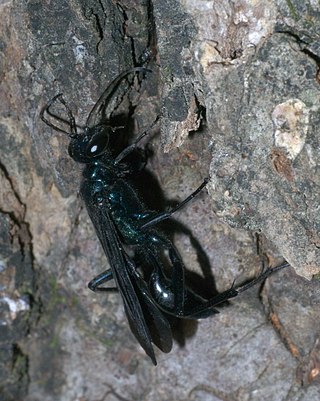
Sceliphrinae is a subfamily of thread-waisted wasps in the family Sphecidae. There are about 6 genera and at least 140 described species in Sceliphrinae.

Macrotera is a genus of bees native to North America, particularly diverse in the desert regions of the United States and Mexico. According to Wilson and Carril, there are "around 30" species of Macrotera. Macrotera are small to medium sized and often black or reddish in coloration. The genus was treated by P.H. Timberlake who, in addition to T.D.A. Cockerell, described most of the known species. Macrotera used to be considered part of the genus Perdita but was split apart by C.D. Michener in 2000. Most species are extreme specialists (oligoleges) with respect to pollen and will only collect pollen from a few closely related species or genera of plants, particularly the plant genus Sphaeralcea and various Cactaceae.
Speyeria carolae, or Carole's fritillary, is a butterfly in the family Nymphalidae. It was described by Cyril Franklin dos Passos and Lionel Paul Grey in 1942 and is found in North America, where it has only been recorded from the Charleston Mountains of Clark County, Nevada. The habitat consists of mountain slopes, foothills and forest openings.

Anthribinae is a subfamily of fungus weevils in the family of beetles known as Anthribidae. There are over 50 genera and more than 80 described species in Anthribinae.
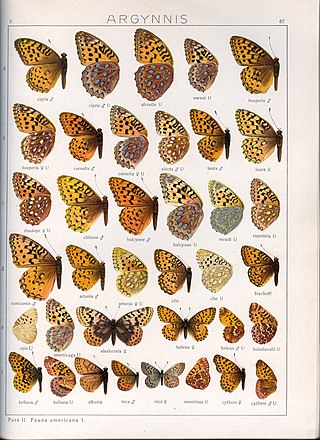
Boloria alaskensis, the mountain fritillary or Alaskan fritillary, is a species of fritillary butterfly in the family Nymphalidae. It was described by William Jacob Holland in 1900 and is found in North America and North European Russia. The MONA or Hodges number for Boloria alaskensis is 4462. The larvae feed on false bistort and alpine smartweed.

Toxophorinae is a subfamily of bee flies in the family Bombyliidae. There are about 7 genera and more than 400 described species in Toxophorinae.

Trachusa is a genus of leafcutter, mason, and resin bees in the family Megachilidae. There are at least 50 described species in Trachusa.
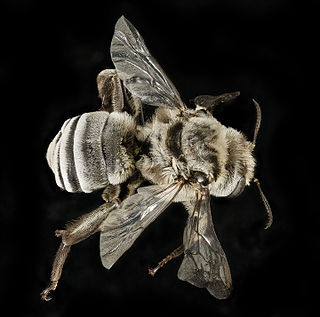
Melitoma is a genus of chimney bees in the family Apidae. There are about 13 described species in Melitoma. Found in the Nearctic and Neotropics.

Neoptilia is a genus of argid sawflies in the family Argidae. There are at least two described species in Neoptilia.

Nomiinae is a subfamily of sweat bees in the family Halictidae. There are about 11 genera and at least 550 described species in Nomiinae.

Neolarra is a genus of cuckoo bees in the family Apidae. There are about 16 described species in Neolarra, all from North America. These bees are smaller than a grain of rice and are kleptoparasites of Perdita bees.

Stenophylacini is a tribe of northern caddisflies in the family Limnephilidae. There are at least 20 genera and 190 described species in Stenophylacini.

Euphydryas anicia, the anicia checkerspot, is a species in the family of butterflies known as Nymphalidae. It was first described by Edward Doubleday in 1847 and it is found in North America.
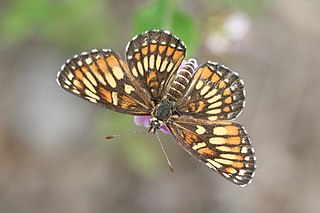
Chlosyne theona, the theona checkerspot, is a species checkerspots in the butterfly family Nymphalidae found in North America. The MONA or Hodges number for C. theona is 4508.
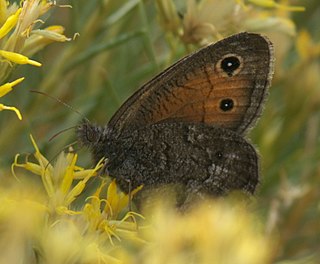
Cercyonis meadii, or Mead's wood nymph, is a species of brush-footed butterfly in the family Nymphalidae. It was first described by William Henry Edwards in 1872 and it is found in North America.
Lomatiinae is a subfamily of bee flies in the family Bombyliidae. There are about 16 genera and at least 290 described species in Lomatiinae.

















